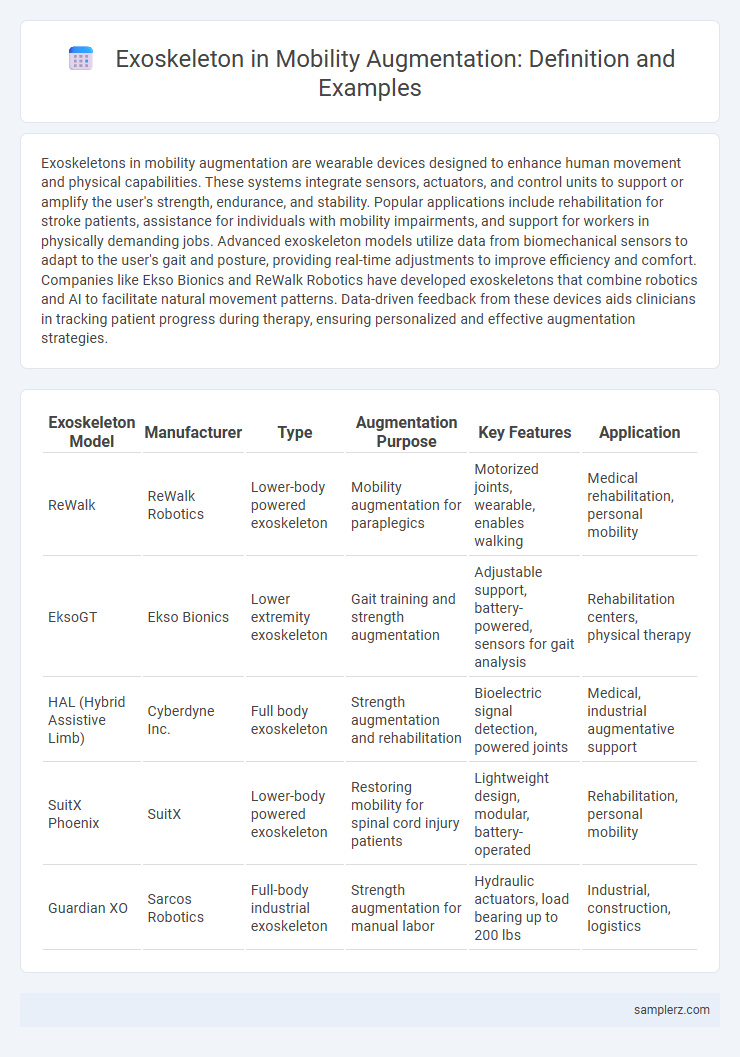Exoskeletons in mobility augmentation are wearable devices designed to enhance human movement and physical capabilities. These systems integrate sensors, actuators, and control units to support or amplify the user's strength, endurance, and stability. Popular applications include rehabilitation for stroke patients, assistance for individuals with mobility impairments, and support for workers in physically demanding jobs. Advanced exoskeleton models utilize data from biomechanical sensors to adapt to the user's gait and posture, providing real-time adjustments to improve efficiency and comfort. Companies like Ekso Bionics and ReWalk Robotics have developed exoskeletons that combine robotics and AI to facilitate natural movement patterns. Data-driven feedback from these devices aids clinicians in tracking patient progress during therapy, ensuring personalized and effective augmentation strategies.
Table of Comparison
| Exoskeleton Model | Manufacturer | Type | Augmentation Purpose | Key Features | Application |
|---|---|---|---|---|---|
| ReWalk | ReWalk Robotics | Lower-body powered exoskeleton | Mobility augmentation for paraplegics | Motorized joints, wearable, enables walking | Medical rehabilitation, personal mobility |
| EksoGT | Ekso Bionics | Lower extremity exoskeleton | Gait training and strength augmentation | Adjustable support, battery-powered, sensors for gait analysis | Rehabilitation centers, physical therapy |
| HAL (Hybrid Assistive Limb) | Cyberdyne Inc. | Full body exoskeleton | Strength augmentation and rehabilitation | Bioelectric signal detection, powered joints | Medical, industrial augmentative support |
| SuitX Phoenix | SuitX | Lower-body powered exoskeleton | Restoring mobility for spinal cord injury patients | Lightweight design, modular, battery-operated | Rehabilitation, personal mobility |
| Guardian XO | Sarcos Robotics | Full-body industrial exoskeleton | Strength augmentation for manual labor | Hydraulic actuators, load bearing up to 200 lbs | Industrial, construction, logistics |
Enhancing Human Capability: Industrial Exoskeletons
Industrial exoskeletons significantly enhance human capability by reducing physical strain during repetitive or heavy lifting tasks, improving worker endurance and safety. These wearable robotic devices are designed to augment muscle strength, decrease fatigue, and prevent musculoskeletal injuries in manufacturing and construction environments. Integration of sensor technology allows real-time movement support, optimizing productivity and minimizing long-term health risks.
Military Applications of Exoskeleton Augmentation
Military applications of exoskeleton augmentation enhance soldier mobility, strength, and endurance by integrating advanced robotics with wearable technology. Systems like the Lockheed Martin ONYX and the Sarcos Guardian XO enable soldiers to carry heavy loads, reduce fatigue, and improve battlefield performance through powered joint support and real-time biomechanical feedback. These innovations optimize combat efficiency, reduce injury risk, and extend operational capabilities in diverse terrains and mission scenarios.
Medical Exoskeletons for Rehabilitation and Mobility
Medical exoskeletons designed for rehabilitation and mobility enhancement provide patients with neurological or musculoskeletal impairments improved gait and muscle strength through controlled robotic assistance. Devices such as the ReWalk and EksoGT systems enable repetitive, precise movement training, accelerating recovery in stroke, spinal cord injury, and multiple sclerosis patients. These robotic frameworks incorporate sensors and actuators to adapt therapy intensity to individual needs, promoting neuroplasticity and functional independence.
Construction Industry Exoskeleton Solutions
Construction industry exoskeleton solutions enhance worker mobility by reducing physical strain and increasing endurance during heavy lifting and repetitive tasks. These wearable devices integrate advanced robotics and ergonomic design to support joints and muscles, minimizing injury risk on construction sites. Leading models, such as suit-type and back-support exoskeletons, improve productivity by enabling longer work periods with reduced fatigue.
Assistive Exoskeletons for Elderly Population
Assistive exoskeletons designed for the elderly population enhance mobility by providing mechanical support that reduces muscle strain and improves balance during walking or standing. These wearable devices use sensors and actuators to detect movement intentions and assist with joint motion, thereby preventing falls and promoting independence. Clinical studies show significant improvements in gait speed and endurance, making assistive exoskeletons a promising solution for age-related mobility challenges.
Logistics and Warehouse Exoskeleton Integration
Exoskeletons in logistics and warehouse operations significantly enhance worker strength and endurance, reducing physical strain during heavy lifting and repetitive tasks. Companies integrating back-support and arm-assist exoskeletons report increased productivity, fewer workplace injuries, and improved ergonomics. Advanced models equipped with AI-driven motion assistance optimize load distribution, streamlining order fulfillment and inventory management processes.
Sports Performance and Exoskeleton Technology
Exoskeleton technology significantly enhances sports performance by providing athletes with increased strength, endurance, and injury prevention capabilities. Advanced wearable exoskeletons integrate lightweight materials and adaptive sensors to optimize movement efficiency and reduce muscle fatigue during high-intensity training. These innovations enable improved biomechanical support, allowing athletes to push physical limits and accelerate recovery times in competitive sports environments.
Agricultural Exoskeleton Use Cases
Agricultural exoskeletons enhance worker endurance and reduce musculoskeletal strain during repetitive tasks such as lifting heavy loads and operating hand tools in farming environments. These wearable robotic suits provide augmented strength, improving productivity and safety in crop harvesting, planting, and livestock management. Companies like Skelex and Hyundai are developing specialized exoskeletons tailored to the physical demands of agriculture, enabling longer work shifts with decreased injury risk.
Emergency Response and Rescue Exoskeletons
Emergency response and rescue exoskeletons enhance mobility and strength for first responders during disaster relief and hazardous operations. Models like the HULC (Human Universal Load Carrier) and the Powered AirLift suit provide augmented load-bearing capabilities, enabling prolonged physical endurance and reducing injury risk. These exoskeletons integrate advanced sensors and actuators to improve stability and optimize rescue efficiency in challenging environments.
Wearable Exoskeletons for Everyday Tasks
Wearable exoskeletons designed for everyday tasks significantly enhance human mobility and strength, enabling users to perform activities such as lifting, walking, and standing with reduced fatigue. Brands like Ekso Bionics and ReWalk offer lightweight, ergonomic suits that improve posture and reduce joint strain in occupational and personal contexts. Emerging models integrate AI-driven motion assistance, optimizing support in real-time for diverse daily movements and increasing overall quality of life.

example of exoskeleton in augmentation Infographic
 samplerz.com
samplerz.com